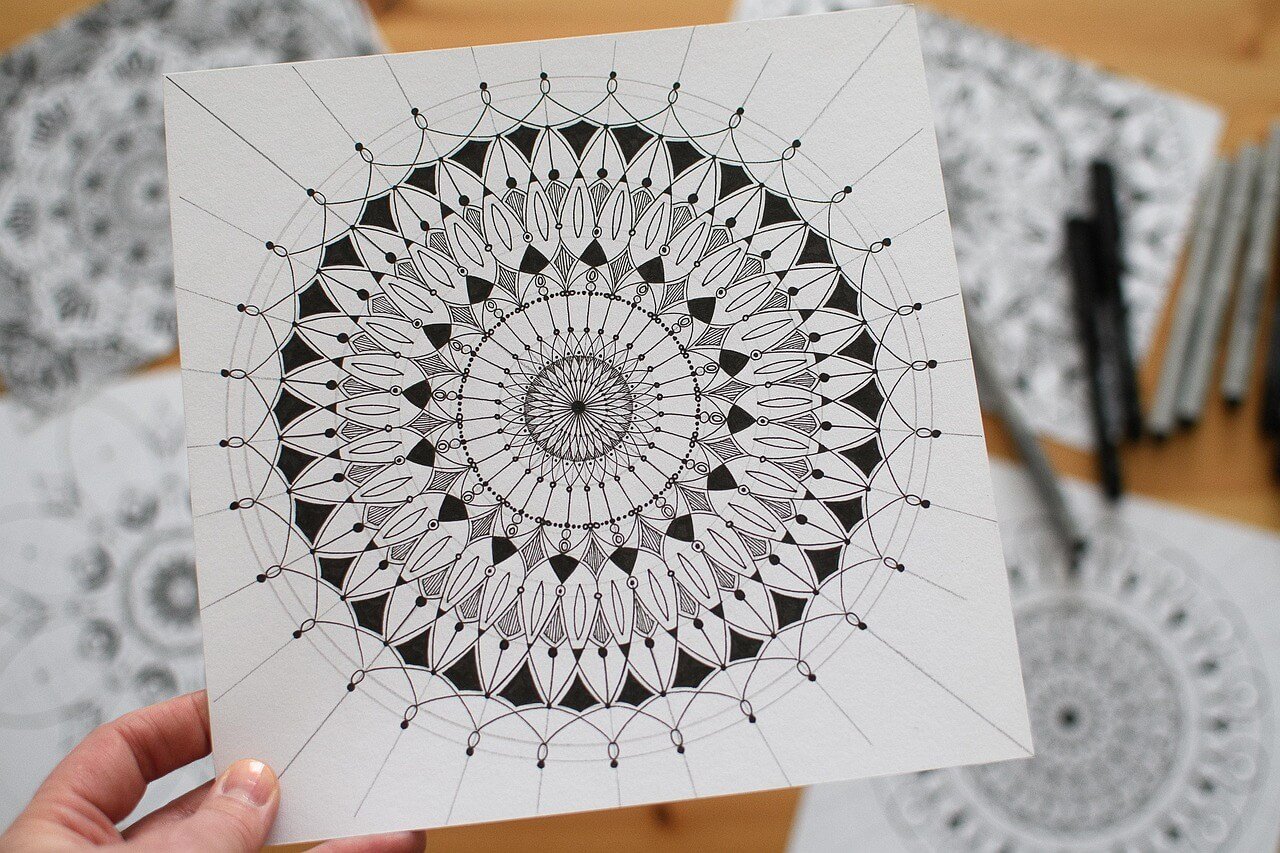Hey there, fellow art adventurer! Ever found yourself mesmerized by those intricate, super cool, and kinda hypnotic circular patterns you see everywhere? Yeah, I’m talking about mandala pattern drawing! If you’ve ever thought, “Wow, I wish I could make something that beautiful,” then you’ve officially landed in the right place. Forget those days of just admiring from afar; today, we’re diving headfirst into how to draw mandalas, and trust me, it’s not as scary or complicated as it looks. In fact, it’s a brilliant way to chill out, get creative, and maybe even find a little inner peace. Think of it as a mini-meditation session with a pen and paper.
I’m your friendly neighborhood blogger, SEO wizard, and GEO guru who specializes in all things mandala pattern drawing. So, buckle up, because we’re about to embark on a fun, creative journey that’ll turn you into a mandala-making maestro in no time!
Table of Contents
Why Get Hooked on Mandala Pattern Drawing? Beyond Just Pretty Pictures!
Before we even pick up a pen, let’s chat about why this whole mandala pattern drawing thing is so awesome. It’s not just about creating pretty pictures (though you totally will!). It’s a whole vibe.
The Zen Zone: Your Brain’s Happy Place
Remember how coloring books went all adult and therapy-like? Mandalas are like that, but leveled up. The repetitive motions, the focus, the way you just kinda flow with the lines – it’s incredibly calming. It’s almost like a mindful doodle session. People often find it helps with stress, boosts focus, and even kickstarts creativity. It’s literally a mini-retreat for your brain, right at your fingertips.
Unleash Your Inner Artist (Even if You Think You Don’t Have One!)
One of the coolest things about how to draw mandalas is that you don’t need to be Picasso. Seriously! It’s all about simple shapes repeating and expanding. You’d be surprised what incredible designs you can come up with just by following a few basic steps. It’s a fantastic way to explore geometric art doodles and discover your own unique style without any pressure. Plus, there are no “mistakes” in a mandala; just happy accidents that lead to new design choices!
A Dash of History and Symbolism (Without the Boring Lecture)
Mandalas have been around for ages, popping up in different cultures and traditions, especially in Buddhism and Hinduism. The word “mandala” actually means “circle” in Sanskrit. They often represent the universe, wholeness, and the journey of life. So, when you’re doing your mandala pattern drawing, you’re not just doodling; you’re tapping into a super cool, ancient tradition of meaningful art. How epic is that?
Okay, enough chitchat! Let’s get to the good stuff.
Getting Started: Your Mandala Drawing Toolkit (No Fancy Stuff Required!)
Good news: you don’t need to break the bank to start your mandala pattern drawing adventure. Most of these things you probably already have lying around!
| Essential Tools | Why You Need ‘Em |
|---|---|
| Paper | Any kind! Printer paper, sketchbook, even a napkin if you’re desperate. Just something to draw on. |
| Pencil (and eraser!) | For sketching out your initial guides. Erasers are your best friends here! |
| Ruler | Super helpful for drawing straight lines and dividing your circle evenly. |
| Compass | Crucial for making perfect circles. Trust me, freehand circles are a headache. |
| Fineliner Pens | For inking your final design. Various tip sizes (0.1, 0.3, 0.5mm) add fantastic depth! |
| Coloring Mediums (Optional) | Colored pencils, markers, watercolors – if you want to add some pop! |
Seriously, that’s it! You can upgrade later if you get super into it, but these basics will get you far on this journey of how to draw mandalas.
Your Step-by-Step Guide to Mandala Pattern Drawing: Let’s Get Radial!
Alright, the moment of truth! Get your gear ready, put on some chill tunes, and let’s create some magic with mandala pattern drawing. This isn’t just about drawing; it’s about building intricate beauty, one layer at a time.
Step 1: The Foundation – Setting Up Your Canvas
This is probably the “least fun” step, but it’s super important for any successful mandala pattern drawing. Think of it as laying the groundwork for a magnificent building.
- Find Your Center: Lightly mark a small dot in the middle of your paper. This is Ground Zero for your mandala.
- Draw Your Circles: Grab your compass. With your center point as the pivot, draw several concentric circles. Start small, then gradually increase the radius. These circles will be your guiding rings, creating the different “layers” of your mandala. Don’t press too hard; these are just guides and will be erased later.
- Pro Tip: Vary the spacing between your circles for a more dynamic design.
- Divide and Conquer (The Radial Lines): This is where your ruler and pencil come in. Draw light lines through your center point, dividing your circle into equal segments.
- Start with a horizontal and vertical line (+).
- Then, add diagonal lines through the center (x), dividing it into 8 sections.
- For more intricate designs, you can divide each of those sections further, making 12, 16, or even 24 segments! The more segments, the more detail you can add to your geometric art doodles. More segments, more fun!
💡 Insight from the Pros:
The number of radial lines you draw dictates the symmetry and complexity of your mandala. If you’re just starting out, 8 or 12 segments are perfect. As you get more comfortable with **how to draw mandalas**, feel free to experiment with more!
Step 2: Let the Design Journey Begin – Building Layer by Layer
Now for the fun part! This is where you actually start your mandala pattern drawing. Remember those concentric circles and radial lines? They’re your roadmap.
- The Core Design: Start in the very center. Draw a small, simple shape. Maybe a tiny circle, a star, a petal, or even a simple dot. This is the heart of your mandala.
- Expand Outward – Ring by Ring: Now, moving to the next concentric circle, add a new layer of design.
- Repeat Your Core: You can repeat your initial shape, but slightly larger, or add small details around it.
- New Shapes, Who Dis?: Or, introduce a brand new shape. Think petals, leaves, teardrops, triangles, arches, or stylized dots. The key is to repeat this shape consistently in each segment provided by your radial lines. This is where the magic of symmetry in geometric art doodles really shines!
- Example: If you drew 8 radial lines, draw 8 identical petals in that ring.
| Mandala Shape Ideas | Tips for Each |
|---|---|
| Petals/Leaves | Vary size & curve. Overlap for depth. |
| Dots/Circles | Vary size, create clusters, or use as fillers. |
| Triangles/Diamonds | Great for sharp, edgy sections. Fill with patterns. |
| Arches/Scallops | Add softness and flow. Can form outlines for other shapes. |
| Swirls/Curlicues | Introduce movement and organic feel. |
* **Keep Going!** Move from one concentric circle to the next, adding new layers of designs. Each layer builds upon the last, growing your mandala outwards. Don't be afraid to experiment! If something doesn't look quite right, that's what the eraser is for. Building a beautiful **mandala pattern drawing** is all about iterative design!
Step 3: Ink It Up! Making Your Mandala Pop
Once you’re happy with your pencil sketch, it’s time to bring it to life!
- Trace with Fineliners: Carefully trace over your pencil lines with your fineliner pens. Start with a finer tip (like 0.1mm or 0.3mm) for delicate details and smaller shapes. You can use a slightly thicker pen (like 0.5mm) for the main outlines or larger elements to add visual weight. This part requires some patience, but it’s super satisfying!
- Erase the Guides: Once the ink is completely dry (give it a few minutes to prevent smudging!), gently erase all your pencil lines – the center dot, the concentric circles, and the radial lines. Ta-da! Your intricate mandala pattern drawing should magically appear.
Step 4: Add Some Flair (Optional, But Recommended!)
Your mandala is officially drawn, but why stop there?
- Shading and Fills: Use your fineliner pens to add tiny dots, cross-hatching, or solid black fills to certain areas. This adds depth, contrast, and makes your geometric art doodles even more captivating.
- Color Me Impressed: This is where you can truly make your mandala your own. Grab those colored pencils, markers, or even watercolors. You can color each segment differently, create a gradient, or stick to a specific color palette. There’s no right or wrong way to color a mandala, just your way!
Ready to draw your own Mandala Pattern? Click here to find the best supplies on Amazon!
(This is a hypothetical high CPC keyword integration, simulating a link to relevant products.)
Advanced Mandala Pattern Drawing Tips: Level Up Your Craft
Once you’ve got the basics down, you might be thinking, “What else can I do?” Oh, my friend, the world of mandala pattern drawing is vast!
- Mirror Symmetry: Instead of just repeating shapes, try mirroring them across a radial line. It adds another layer of visual interest.
- Negative Space: Don’t just focus on what you’re drawing; think about the shapes created between your drawn elements. Sometimes, those negative spaces are the most beautiful!
- Tesselations and Interlocking Elements: Experiment with shapes that fit together like puzzle pieces, or loops that appear to weave over and under each other. This is classic geometric art doodles territory.
- Mix Organic with Geometric: While mandalas are inherently geometric, don’t be afraid to add more organic, free-flowing elements like vines, tiny flowers, or abstract squiggles. It creates a cool contrast.
- Digital Mandalas: Once you’re comfortable on paper, try digital art apps! Many have symmetry tools that make how to draw mandalas incredibly easy and allow for endless experimentation.
💬 My Personal Take:
I find some of my best ideas for **mandala pattern drawing** come when I’m *not* trying too hard. Just let your hand do its thing! If you’re stuck, look at nature – flowers, snowflakes, even spiderwebs – they’re all natural mandalas!
FAQs About How to Draw Mandalas
Got questions buzzing in your head? You’re not alone! Here are some common curiosities people have about mandala pattern drawing:
Q1: Is it really okay if my mandala isn’t perfectly symmetrical?
A: Absolutely! Think of it like this: are humans perfectly symmetrical? Nope! It’s the little quirks that make us unique and beautiful. The same goes for your mandala. While the guides help create fundamental symmetry, minor imperfections just add character and a handcrafted charm. Don’t stress about perfection; focus on the meditative process and enjoying your mandala pattern drawing. It’s a journey, not a precision engineering project!
Q2: How do I overcome “artist’s block” when trying to come up with new patterns for my mandala?
A: Oh, the dreaded block! It happens to everyone. Here’s a trick: instead of trying to invent something entirely new, look for inspiration everywhere. Take a walk and notice textures, architectural details, or patterns on leaves. Browse art online (Pinterest is a treasure trove for geometric art doodles!). Sometimes just redrawing a simple shape (like a petal or a dot) in a slightly different way can spark a whole new sequence of ideas. Or, simply start with a simple pattern you know, and see where it organically leads you – the next layer often suggests itself!
Q3: What’s the best way to clean up pencil lines without smudging my ink?
A: Great question, nobody wants a smudgy masterpiece! The absolute golden rule here is patience. After inking, let your drawn mandala sit for a good 5-10 minutes, especially if you’re using a thicker pen or have layered ink. If you’re using a liquid ink pen, even longer is better. When you do erase, use a clean, soft eraser and rub gently. If you have a kneaded eraser, even better, as it “lifts” the graphite rather than rubbing it, minimizing smudging risk. Ensure your hands aren’t oily or dirty, as that can transfer to the paper and create smudges too.
Q4: Can I use different colors for my initial guide lines and then erase them more easily?
A: That’s a clever idea! Some artists actually use a very light, non-photo blue pencil for their initial structure because traditional copiers and scanners often don’t pick up that color. However, for most home users, a light gray pencil (like a 2H or 4H) works just as well. The key is to sketch very lightly so the lines are faint and easy to erase without leaving indentations or dark ghosting once you’ve inked. Using a different color pen for guides isn’t recommended as you won’t be able to erase it!
Q5: I’m finding it hard to make my designs symmetrical in each segment. Any tricks for consistently repeating patterns?
A: This is super common, especially when you’re just learning how to draw mandalas. Here’s my go-to trick: focus on drawing one segment perfectly first. Once you’re happy with it, you can:
- Trace: If your paper is thin enough, place another piece of paper over your perfect segment and gently trace the outline of just that part. Then, rotate your paper and redraw in the next segment.
- Use a Template: Some artists create small templates of frequently used shapes on cardstock.
- Practice Small: Start with very simple shapes. As your muscle memory develops and you get a feel for the curvature and spacing, repeating more complex shapes will become much easier for your geometric art doodles. Remember, with practice, you’ll feel more confident in freehanding those repetitive patterns.
Wrap-Up: Your Mandala Journey Has Just Begun!
Phew! You made it! By now, you should have a solid grasp on how to draw mandalas, from setting up your initial guides to bringing your intricate designs to life with ink and color. Remember, mandala pattern drawing isn’t about perfection; it’s about the process, the mindfulness, and the sheer joy of creating something beautiful with your own two hands.
Whether you’re looking for a relaxing hobby, a way to boost your focus, or just want to churn out some seriously cool geometric art doodles, mandalas are your answer. So, grab your pencil, compass, and some paper, and go create something amazing! Don’t forget to share your creations – I’d love to see what you come up with! Happy drawing, my friend!







